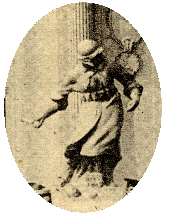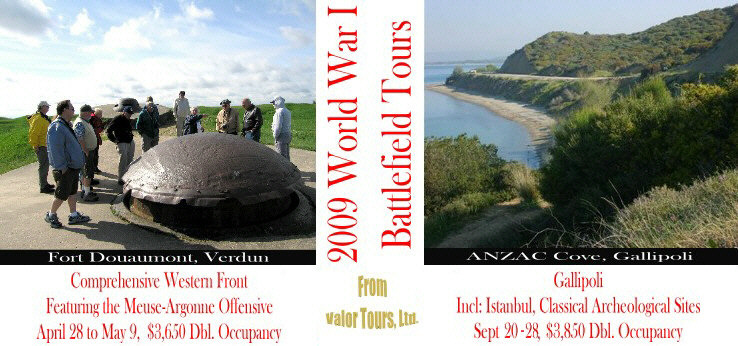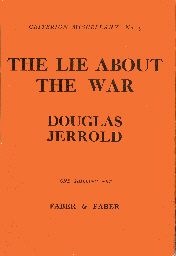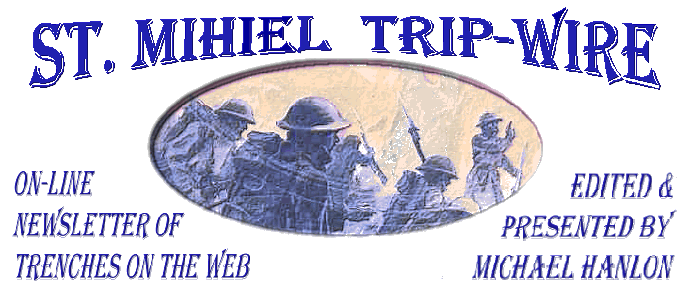
TRENCH REPORT: I hope your September was as successful in its high points, but devoid of the low points, as mine. First the highlights. The small group I led to the Western Front for Valor Tours had a great time. The reenactment of the opening of the Battle of the Marne was well done. Next month, we will be presenting photos from Tony Langley, Trip-Wire contributor, who served as our guide and translator. As usual, we were treated like visiting celebrities by the Superintendents at the Aisne/Marne and Oise/Aisne cemeteries. Later on, Teddy Colligan, Guardian of Ulster Tower on the Somme Battlefield, gave us a tour of the newly restored 36th Division trenches in Thiepval Wood [More on my 2009 tours below]. . .On the way back to California, I was also able to stop at the annual WFA-USA National Seminar conducted this year at the Army War College at Carlisle. It was very well organized, with excellent speakers, like WWI authors Steve Harris and Ed Lengel, outstanding food and a fascinating locale--we convened just yards from an authentic-looking Great War trench. . .There was also some very BAD for me in September. I had a tooth go south (or west?) while in France that I held off on having extracted until I returned home. Luckily, I had some warning of the impending disaster, so I packed some pain medicine left over from a previous dental emergency. . .That crisis, however, paled before a computer disaster that I discovered the day before I left for France. Our hosting company lost a series of hard drives. They lost not only our current issue of the Trip-Wire but also the most current backup files on several related sites. On another computer, they found a May 2007 backup, which they installed fairly promptly, and promised to do a full reinstall covering the intervening period while I was in France. Some of you have seen the results of that failed effort and have written to me about missing articles and images in the various sites I maintain including: Trenches on the Web and the Great War Society. My apologies for this breakdown. I've spent the last week reinstalling the missing files from my personal backup folders. So things are mostly up-to-date now. Let me know, though, if you find anything missing, either articles or images. Well, on to October. MH
This Month's Internet Feature
End Game on the
Italian Front
Monte Grappa, Italy's Thermopylae
Allies' Post-Caporetto Support of Italy
Doughboys in Italy
Sinking of Austrian Dreadnought SMS Viribus Unitis
The Battle of Vittorio Veneto
1918 Map of Italian Front
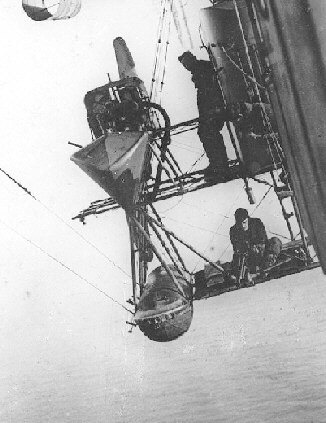
Airship Machine-Gun Outpost
New at Our Own & Our Friends' Great War Websites
Click on Title or Icon to Access
|
At Great War Society Sites
At the WFA-USA
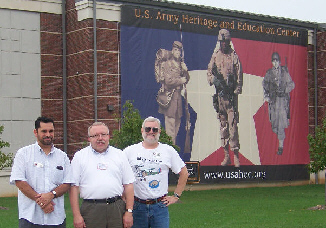
WFA-USA New Officers
Elected at the Recent National Seminar (L-R)
Jeffrey Lamonica-Secretary; Doran Cart-President;
Steve Suddaby-V.Pres. (Event Photos )
|

While almost everyone, including historians, would rate Alexei Brusilov the best Russian commander of the war, a case can be made that their most successful general was the little-remembered Nikolai Yudenich, commander on the Caucasian Front. He utterly destroyed Enver Pasha's 1914 offensive, and later, when subordinated to Grand Duke Nicholas, he won repeated successes. In 1916 he won victories at Erzerum, Trebizond and Erzincan. Later, in the Civil War, he would command badly outnumbered White forces on the critical Petrograd Front but would ultimately be forced to flee and would die in exile in France in 1933.
 This rare WWI DH-9 bomber that was discovered in a maharaja's elephant stable in India [imagine a barn the size of the Pentagon] has been painstakingly restored for of the UK's Imperial War Museum
|
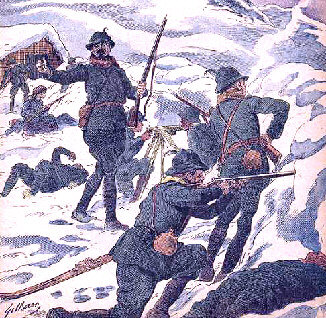
Italian Hero Cesare Battisti in Action
Cover, Italian Magazine Collection Patrie
Battisti was later captured by Austrian forces and, since he was an Austrian citizen, executed for treason.
GREAT WAR 2008 EVENT CALENDAR
|
WWI Military History Symposium
South Carolina Confederate Relic Room & Military Museum Columbia
Lectures, Living History, WWI Authors
November 15, 2008 Email Sarah Wooton Garrod at: swooton@crr.sc.gov for information
|
Western Front Association
U.S. Branch Chapter Meetings
Check for Your Region
Regularly Updated (details)
|
Great War Society Monthly Chapter Meetings
Berkeley, San Francisco and Palo Alto, CA
Regularly Updated (details)
|
Send additions/corrections:
Email Response
|

Memorable Event
|
Germany Requests
An
Armistice
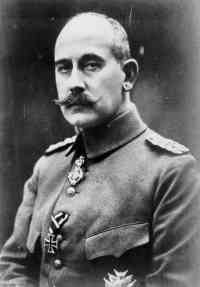
German Chancellor
Prince Max von Baden
October 4, 1918
Click on Image to Learn More
|
|
Passchendaele, the Canadian-produced film, opens in theaters across Canada on Oct. 17, 2008
Call for Papers: Symposium on Gallipoli -- Gallipoli and the National Imagination, 15-16 April 2009 sponsored by the Centre for Arab & Islamic Studies (The Middle East & Central Asia) at The Australian National University, Canberra, (email for details).
Go to London! Take the Tube to the Elephant and Castle station! Walk to the Imperial War Museum! Visit a Remarkable 90th Anniversary Exhibit on the war's end! (link)
| With the completion of the recent Olympic games in Beijing, it's well to recall the impact of the Great War on the international sports festival. The 1916 games--scheduled for Berlin--had been cancelled, and the next games were destined to be held in the shadow of the war. Nevertheless, the VIIth Olympiad, held in Antwerp, Belgium--a city occupied for most of the war--was strikingly different from any earlier or subsequent event. The selection process for the site, who would be invited to compete, the preparations and the military aesthetic and sensibility that permeated the games were dramatically influenced by the war. Consider this: Conspicuously located outside Antwerp's Olympic Stadium was a statue of a "competitor" executing a difficult athletic throw. The figure, however, was not an athlete but a soldier. And he is not launching a discus or a javelin but a hand grenade.
|

The essential idea which governed me was that the battle of 1916 [Verdun + Somme] had so thoroughly disorganized the enemy's defenses and the German reserves had been used up to such an extent that, if we now made a supreme effort, we could hardly fail to obtain decisive results [in 1917].
General Joffre, November 1916
In next month's OVER THE TOP Magazine, USAF Academy professor Mark Grotelueschen examines the most important American operation of the First World War: the November 1, 1918 attack in the Argonne that culminated that offensive and helped define the American way of war for the next century.
|
2009 World War I Tours Led By Trip-Wire Editor Mike Hanlon
Click on image to request a brochure from greatwar@earthlink.net
|
|
|
|
Page Two
|
|
|
|
|

|
Eparges Spur
St. Mihiel Salient
By Christina Holstein
|
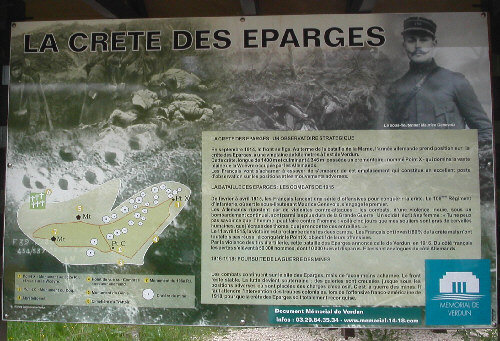
Informational Kiosk at Eparges Spur
Visitors to the Western Front are always surprised by the number and extent of interesting sites near the town of St. Mihiel. Most tourists know about the American victory in the area in September 1918, but the area is really an outdoor museum of the effects of four years of attritional warfare.
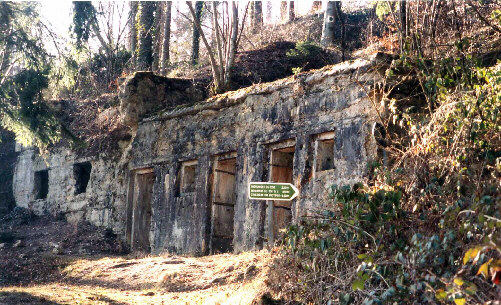
German Bunker, Known as the "Crown Prince Bunker," Built Into the Hillside
North of the town of St. Mihiel and southeast of Verdun runs a line of hills that offer wide views to both east and west. Known as the Côtes de Meuse, these hills were extremely important for observation at the start of World War 1 and were the scene of serious fighting. The most important is Les Eparges, from which on a clear day the views stretch to the hills above Metz, some 40 kilometres to the east. Seized by the Germans in September 1914, Les Eparges became the scene of vicious fighting in 1915, as the French sought to recapture the position. Each side resorted to mine warfare in an attempt to blow the other off the hill and by the end of the war, the top of the hill was dotted with huge mine craters. Underground the Germans had driven a great system of shafts and galleries, wired for electric light and containing narrow gauge railways. Leading from the galleries were large chambers, with some fitted as barracks, others as kitchens and supply rooms. Stairways ran up to the trenches above ground, while a central shaft descended still further into the hill.
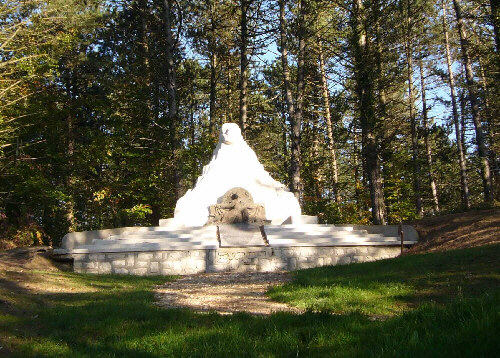
Monument to the French 106th Infantry Regiment on the High Ridge
Unlike the Butte de Vauquois, a similar position to the west of Verdun where a local association has explored the French and German underground workings, none of the Eparges installations has been explored and there are no plans to open the system to the public. It remains a place of French monuments and wonderful views, beautiful and peaceful in summer and in winter one of the coldest places in northeastern France.
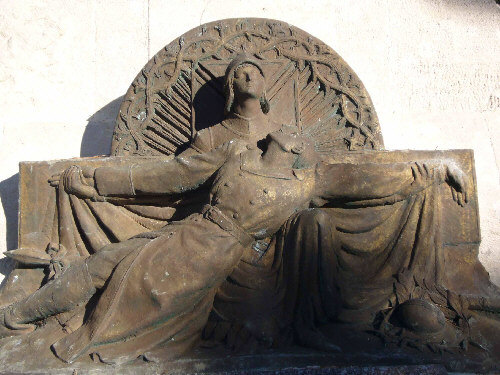
Detail of the 106th Monument
|
The Lie About the War
A 1930 Critique of War Literature, by Douglas Jerrold
|
Conservative historian and publisher Douglas Jerrold, a man once described as "an uncompromising controversialist", in 1930 found himself quite dissatisfied with the literature--both fictional and memoirs in the form of novels--taking the war as its subject. He published a scathing pamphlet titled The Lie About the War that grouped together such recent "best sellers", which are now rated the war's "classics", as All Quiet on the Western Front, Good-bye to All That, Under Fire, The Secret Battle, Storm of Steel, The Enormous Room and the Spanish Farm Trilogy, and described what he saw as their common and central flaw. I believe the excerpt below captures the heart of Jerrold's argument. Incidentally, in the 1950s Jerrold became better known for publishing an equally powerful rejection of the works of mega-historian Arnold Toynbee.
These books all reflect (intentionally or otherwise), the illusion that the war was avoidable and futile, and most of them reflect the illusion that it was recognized as futile by those who fought it. It is this obsession of futility, not any special depth of sympathy or humanitarianism which accounts for the piling up of the individual agony to so many poignant climaxes remote from the necessities or even from the normal incidental happenings of war. The suffering, the horror and the desolation is presented always and brutally as without a meaning so far as the declared purposes of the struggle are conceived, because these declared purposes are, to the writers and critics of the moment, either so many impudent and deadly frauds or so many irrelevancies, to the achievement of which the blunders and crimes of the military were only so many obstacles.
Now these writers are too gifted not to know that if the sufferings of the war were really futile and superfluous or its incidents irrelevant, the sufferings would in themselves be utterly without significance. These writers know as well as I do that the only possible tragedy of the war, considered as war, lay in its inevitability, that to deny the element of fatality must be to deny that it was a tragedy at all. Yet to accept the element of fatality would be to invest the war with a grandeur which these novelists are determined to deny it. Hence the frantic attempt to get the dramatic quality out of every kind of struggle except the struggle of one army against another and so to get a significant novel without having to admit that it was a significant war.
The struggle of the coward against fear, of the artist's sensibility and refinement against progressive brutalization, of the brave man against exhaustion, of the 'line' against the Staff, of the amateur against the professional soldier, of the individual against authority, all lead up to and are subservient to the ultimate and wholly mendacious struggle of the man of peace against war [in Remarque's words:] 'the fighting, the terror, the mastery, the power and the tenacity of the vital forces of the individual man faced with death and annihilation'. To put it another way; perhaps gaining in vividness at the expense of exact analysis, the real tragedy of the war is being falsely reported as the death of so many men whose duty it was to live, whereas the real tragedy was that duty offered no alternative but death. And it was for this reason that death was accepted, not in fear, not in sullen indifference or in open or suppressed revolt, but deliberately and in the face of countless opportunities of evasion.
This is where the crime against mere veracity begins to show. To establish the dramatic quality of the secondary and sometimes wholly imaginary struggles which make up the tale of these unmilitary epics, every essential fact is falsified, either objectively or by an illegitimate technique.
A French critic [Jean Norton] has accumulated a catalogue of objective errors in some of the more popular works. I hesitate to follow in his footsteps because it is impossible to establish a negative. What is happening today is precisely what happened in 1914 in the matter of the German 'atrocities' in England and in 1919 of French 'atrocities' in Germany. A grotesque legend is being built up on a slender basis of hearsay. . .
|
|
|


Trench Excavation Near Fort Douaumont, Verdun Battlefield, 1917
Click Here to Visit War in a Different Light
|

|
1918 on The Western Front
By Tony Noyes
October
The End Nears
|
[Tony is still indisposed this month, so we have drawn on other sources for this month's entry.]
All the Allied offensives launched on the Western Front in September met with various levels of success throughout October. [See status in the right column.] A major French/U.S. offensive in the east was being planned for November 14th for the next phase.
However, the big news was that Germany had decided early in October to seek an Armistice. The terms implicit in Woodrow Wilson's Fourteen Points seemed to offer the promise of the most reasonable settlement from their point of view, so the first approach was made to America. The ensuing jockeying among Allies and between the Allies and Germany would consume another month and tens of thousands of casualties as the multiple battles on the Western Front continued with full force.
Meanwhile, Italy went on the offensive at Vittorio Veneto decisively defeating the shattered and dissolving Austro-Hungarian Army. General Allenby's forces arrived in Damascus, and hostilities ended in Mesopotamia with an Allied victory at Sharqat. At the end of the month Turkey left the war. The end was approaching.
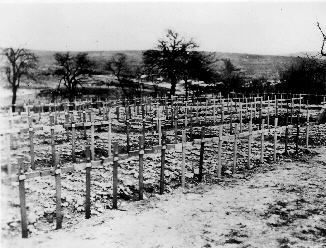
Graves from the War's Last Month
|
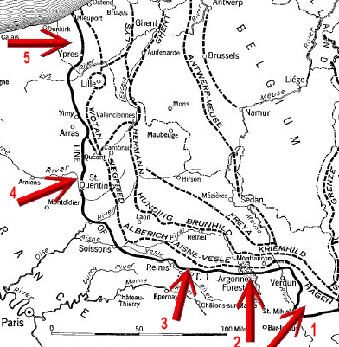
31 October 1918 Status of Allied Offensives Launched in September
- 1. St. Mihiel
- U.S./Fr., Launched 12 Sep.
Salient Reduced, U.S. Second Army preparing offensive ag. Metz
- 2. Meuse-Argonne
- U.S./Fr., Launched 26 Sep.
U.S. First Army bogged down on mid-Argonne heights, preparing for renewed attack 1 Nov.
- 3. Champagne
- Fr. IV Army, Launched 26 Sep.
Blanc Mont Captured; Champagne abandoned by German Army
- 4. Somme
- Brit./U.S., Launched 29 Sep.
German Army retreating under extreme pressure
- 5. Flanders
- Belg./Fr./Brit./U.S. Launched 28 Sep.
Reinforced for renewed attack in late October
|
If you are travelling to Europe and would like to visit these fields of memory for a detailed tour, please contact experienced guides Tony Noyes or Christina Holstein at Verdun Tours
|
|
Subscribe to Our New On-Line Magazine
|

|
|
|
Page Three
|
 |
What the National Security Community Reads
About World War I
Selections from the Warlord Loop
|
The Warlord Loop is a by-invitation-only email forum open to military and civilians who work in America's national security apparatus. Organized by John M. Collins, career soldier and for a quarter century the leading military and defense analyst at the Congressional Research Service, the group recently produced a broad, eclectic reading list that was published in the August 2008 Proceedings of the Naval Institute. The group includes several Trip-Wire subscribers, and not surprisingly, the Warlord listing includes a number of WWI classics and broad works that touch on the war:
- War Made New: Technology, Warfare and the Course of History by Max Boot
- Shell Shock to PTSD: Military Psychiatry From 1900 to the Gulf Warby Figley and Nash
- The General by C.S.Forester
- A Peace to End All Peace by David Fromkin
- Battle Tactics of the Western Front by Paddy Griffith
- Strategy by Basil Liddell Hart
- Perception and Misperceptions in International Politics by Robert Jervis
- Seven Pillars of Wisdom by T.E. Lawrence
- Promised Land, Crusader State: The American Encounter with the World Since 1776 by Walter McDougall
- Once An Eagle by Anton Myrer
- Thinking in Time: The Uses of History for Decision-Makers by Neustadt and May
- Until the Last Trumpet Sounds [General Pershing bio] by Gene Smith
- Fix Bayonets! by John Thomason
|
World War I Headlines
in the
21st Century
|
|
Rin-Tin-Tin
By Andrew Melomet
In Lorraine, France on the morning of September 15, 1918, an American soldier, Corporal Lee Duncan, found an abandoned German war dog station. Inside the bombed-out dog kennel were a starving mother and five puppies. Duncan rescued them all. Three of the puppies found homes in Europe. Duncan took a female and a male back home with him. He named them after the good-luck dolls the French gave to their soldiers, Nenette and Rintintin. Nenette died of distemper, but Rin-Tin-Tin survived. Duncan sought out the German kennel master, who had been captured by the Americans, to learn more about the breed.
After the war Duncan returned to his job at a hardware store and attended dog shows. Impressed with the dog's learning abilities Duncan (and his army friend, Eugene Pallette) raised and trained Rinty to perform stunts and obey his commands, preparing him for future stardom. Rinty first found fame when footage of him making a record-breaking jump of eleven feet nine inches appeared in a newsreel.
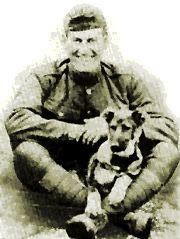
Cpl. Duncan & His Discovery |
Duncan tried to get Rinty into the movies but was turned down by one studio after another. There were plenty of other animal stars in Hollywood. In fact, there was another starring German shepard in the twenties, "Strongheart" who was hailed by Photoplay magazine as "a dramatic dog; an emotional actor." "Strongheart" was his stage name; he had been born "Etzel," and Photoplay assured its readers he had served in the German Red Cross in the World War.
In 1922 Duncan came across a film crew having difficulty filming a wolf. He went to the producer and convinced him to try Rinty. The troublesome scene was completed in a single take. Rinty was used for the rest of the production, Man from Hell's River. It was Rinty's big break.
In 1923 producer Henry Rapf approached Jack Warner, head of Warner Bros. to discuss making Where the North Begins, a story about a dog running with a pack of Canadian wolves who befriends and rescues a fur trapper. There was a slight problem--they needed a performing dog. But Rapf told Warner he knew Lee Duncan who had a trained German shepard. Jack Warner wanted to met Duncan and the dog before giving the go-ahead. So Duncan and his dog were introduced to him.
Upon entering Warner's office Duncan sat in a sofa chair and pointed with his index finger at his right foot. The dog sat next to his foot. Duncan told Warner how he had found the dog in France. Warner asked if the dog did tricks. Duncan said he obeyed commands. Warner asked for a demonstration. Duncan made a quick hand motion. The dog rose, bared his teeth, and growled at Jack Warner. Warner had once been bitten on his arm by a chimp being used in a movie and the growling dog scared him. He asked Duncan to call the dog off. With a snap of Duncan's fingers the dog relaxed. Duncan pointed to a large chair across the room and made another gesture. The dog ran across the room and jumped over the chair and then returned to Duncan's side. Warner asked the dog's name. "Rin-Tin-Tin" was the reply.
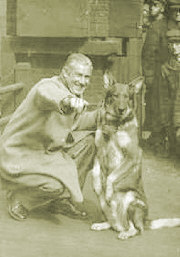
On a Movie Set |
Where the North Begins was the first of Rinty's hits that helped make the studio solvent. The films he made from 1923 to 1930 earned over $5 million for Lee Duncan. Jack Warner often called Rinty the "Mortgage Lifter." Warner also liked that, unlike other stars, Rin Tin Tin "didn't ask for a raise, a new press agent, or an air-conditioned dressing room, or more close-ups."
There was a formula to most of the Rin-Tin-Tin movies with Rin-Tin-Tin performing action stunts and completing a major task to save the day for his seemingly helpless and confused human stars. The plots are simple and filled with action. They utilized Rinty's athletic skills and acting abilities.
In The Clash of the Wolves (1925) Rinty plays Lobo, a wolf-dog half-breed. Lobo, his mate, puppies and other members of the wolf pack are forced out of the Sierras by a forest fire. When a thorn in his paw threatens his survival, Lobo is rescued by a friendly prospector, played by Charles Farrell. Rinty returns the favor by saving his life from a claim jumper played by Pat Hartigan and helping his romance with June Marlowe (who appeared in five Rin-Tin-Tin features). Lobo has a bounty on his head, so Rinty wears a disguise when in town. In one scene he unlaces his booties to climb up a slippery sloping chute to hurl himself at the villain. When his friend is shot and hiding in a cave Rinty tries to give a message written on a canteen to the heroine, but she's so clueless she gives the canteen to the villain without reading the message.
The Clash of the Wolves is the only Rin-Tin-Tin feature currently available in a restored print on DVD. A 35mm South African print was repatriated through the American Film Institute to the Library of Congress and preserved in 2003. The Clash of the Wolves is included in the box set, More Treasures from American Film Archives 1894-1931.
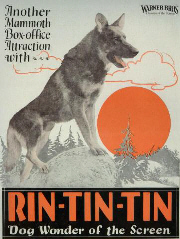
Rin-Tin-Tin, Megastar |
Darryl F. Zanuck was working for Warner Bros. as a writer at this time, and he helped to develop the stories that would turn Rinty into a major star. In 1917, prior to America's declaration of war Zanuck had lied about his age and enlisted in the Nebraska National Guard. As member of the U.S. Army's 34th Division, Zanuck went to France, where he served as a runner and a messenger. He was the only studio head (20th-Century Fox) to have had combat experience in World War One.
D. Ross Lederman, who directed Rinty in The Million Dollar Collar (1929) commented that "When I worked with him we needed very few retakes and almost no extensive rehearsing. That dog knew just what was expected of him. He would watch Duncan for a signal, if movement was required. He couldn't tell time. But as for emoting, or playing a scene right, he didn't need any coaching. That's the unusual thing about that dog. He actually seemed to understand the story line well enough to bring off his role better than most of the other actors in the picture. I had more trouble with Tim McCoy and Buck Jones later at Columbia than I ever had with Rinty at Warner's. He was one of the few truly professional actors we had in Hollywood at that time. He just went about his business."
At the peak of his career, Rinty received 12,000 fan letters a week, earned $6,000 a month and had a valet, a chef, a limo (and driver). Like other silent stars, he had mood music played by an orchestra while he worked. He wore a diamond-studded collar off camera. He had an endorsement contract with Ken-L Rations who used his photograph on their boxes. He was cited by Duncan's wife as the cause of her divorce. He lived the life of a star. He collapsed on August 10, 1932 after playing with Duncan outside their home. Neighbor Jean Harlow ran over from across the street and cradled Rinty's head in her lap as he died. Duncan returned Rinty to France to be buried in the Cimetiere des Chiens, the famed pet cemetery in Asnieres-sur-Seine. Rin-Tin-Tin has a star on the Hollywood Walk of Fame.

This Rin-Tin-Tin Classic Is Available on DVD Today
During World War Two, Duncan contributed to the war effort by training more than 5,000 military dogs and handlers. After the war, he untrained many of the dogs to allow them to be returned to their donating families. Lee Duncan died on September 20, 1960.
Finding Rin Tin Tin was released on DVD in September, 2008. Filmed in Bulgaria, it is a highly fictionalized telling of Rinty's discovery on the battlefield in France. However, it does not use any of Rinty's descendents as actors. Miss Daphne Hereford, owner/breeder of the Rin-Tin-Tin line and the associated trademarks has expressed her concerned that this release is deceiving the public. I can say that the best part of Finding Rin Tin Tin is the Bulgarian scenery.
|
|
| | |















